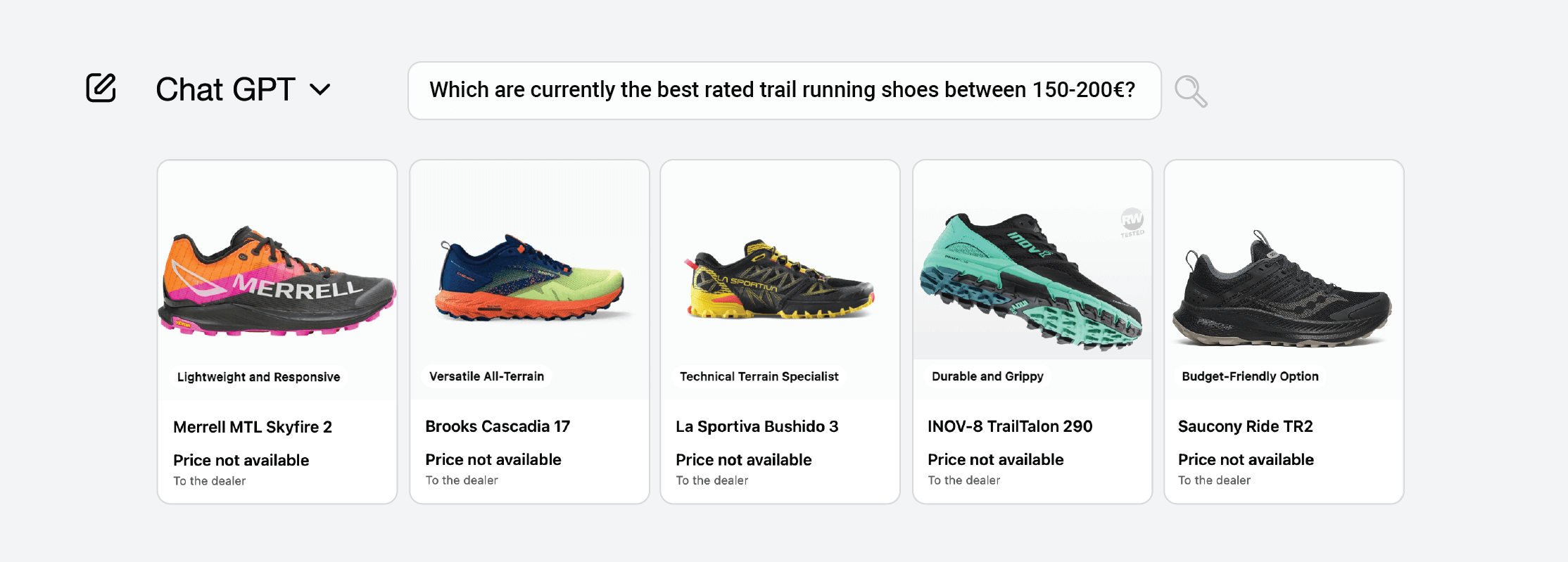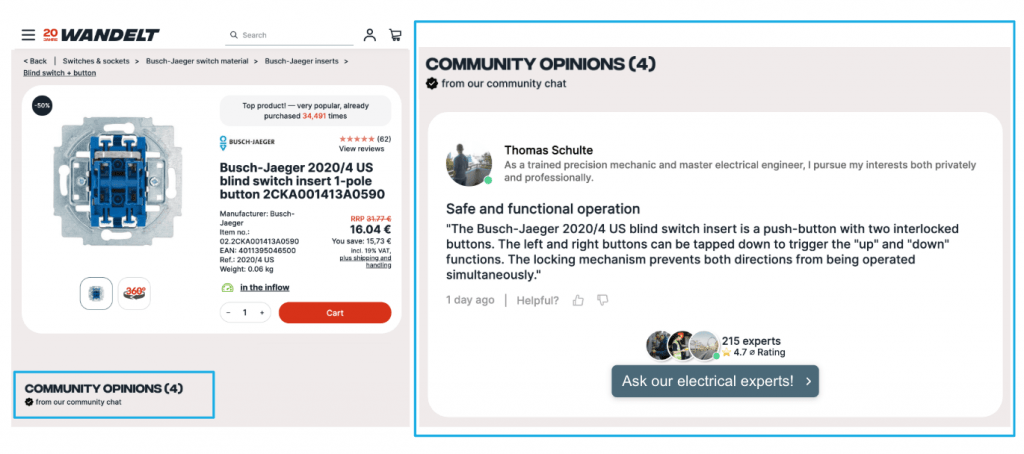
By GUURU News -

AI Eats Search: What eCommerce Brands Must Know in 2025
How can brands stay visible in an AI-driven search landscape
This article covers:
- The shift from traditional Search Engine Optimization (SEO) to AI Optimization (AIO).
- How Google and large language models (LLMs) interpret your content.
- The types of content and structures that AI prefers.
- Practical strategies your brand can implement today to maintain and improve visibility.
Introduction: The New Search Paradigm
Search isn’t just ten blue links anymore. Conversational engines like ChatGPT, Google’s Search Generative Experience (SGE) and Perplexity now answer shoppers’ questions directly, often without a click. To stay visible in this new world, brands have begun treating AI Optimization (AIO) as the next layer on top of classic SEO. AIO focuses on making content easy for large-language-model (LLM) systems to understand, trust and surface.
Understanding Google’s AI Overviews and Their Implications
AI overviews, also called Search Generative Experience (SGE), sit on top of Google’s search result pages catching the attention of buyers and directly providing answers about the products they’re looking for as well as shopping results–ultimately leading them into making a purchasing decision before listed pages even matter at all.
Organic search still drives roughly 40% of e-commerce visits, yet AI overviews can push those listings 1500 pixels down the page, siphoning attention and clicks, and leaving brands worried about sudden traffic drops and the loss of control over how their products appear. (Charles Agency, 2024)
According to Ahrefs, Google’s new AI-driven Search Generative Experience (SGE) is already depressing organic traffic: queries that trigger an AI Overview show a 34.5 % lower average click-through rate for the top-ranking page than similar keywords without the feature. Because SGE answers the question directly on the results page—often listing many citation links—fewer users feel the need to click through, and no single site captures a dominant share of the remaining clicks. Several publishers have already reported organic traffic will likely decline in the 20–40% range after the rollout of AI summaries. (Ahrefs, 2025)
Brands that have a significant portion of web store traffic coming from organic search need to start optimizing not only for search engines like they used to but also for large language models behind these generative AI’s.
The Rise of Generative Search Platforms
These generative search experiences are actively changing how people search. Many users are now turning to AI chatbots and assistants for questions they used to search on Google, eroding the dominance of traditional search engines. Notably, Google’s share of the search market dipped below 90% in late 2024, the first time in many years, as ChatGPT and similar AI platforms captured a slice of query volume. (surferseo.com, 2025)
Consumer behavior is shifting rapidly toward AI-assisted shopping. A March 2025 survey found that 61% of consumers have used a general AI like ChatGPT or Google’s Gemini to help them shop online. More than half of shoppers said their search queries have become more conversational in the past year, moving away from terse keywords. Shoppers – especially Gen Z and Millennials – are clearly showing they want search to feel like a dialogue. Brands must note this trend and ensure their content (both on their e-commerce site and across the web) can satisfy these natural-language queries that AI platforms and chatbots are fielding every day. (bloomreach.com, 2025)
In fact, generative AI web traffic exploded by over 1,200% between mid-2024 and early 2025, reflecting mass adoption of AI assistants for information retrieval. Google itself has reported that its new AI overview feature (Search Generative Experience – SGE) is seeing heavy usage, with the CEO revealing SGE was serving roughly 1.5 billion user interactions per month by the start of 2025. Meanwhile, standalone AI Q&A services like ChatGPT have grown to hundreds of millions of active users. The takeaway is that a significant portion of the audience, from casual consumers to business researchers, is now getting answers from generative AI directly, without always clicking through to websites. This shift forces online businesses to expand their visibility strategy beyond just traditional search rankings and consider how they can appear in AI-driven results. (surferseo.com, 2025)
Another surprising new research suggests the impact of AI answers on clicks isn’t purely negative. A Semrush study of 10 million searches found that by March 2025 about 13% of all queries showed an AI Overview (double the rate in January). These AI snapshots often cover informational questions, yet zero-click behavior did not uniformly spike when they rolled out. In fact, for the same set of keywords, the average zero-click rate slightly declined from 38.1% to 36.2% after AI answers were introduced. It appears users will still click through if the AI overview cites a compelling source or leaves them curious. The takeaway: generative search is changing behavior, but a strong content snippet can still earn the click – so ensure any info the AI pulls from you is engaging enough to entice readers. (semrush.com, 2025)
Decoding AI Search: How do Large Language Models Operate?
First, remember that not all large language models work in the same way. For example Perplexity and ChatGPT have very different approaches.
To generalize, LLM’s pull from two reservoirs: a frozen snapshot of the public web and, when browsing is enabled, a live stream of up-to-the-minute search results—much like a super-smart intern who answers from memory but will also “Google” the latest facts for you.
LLMs love content that:
- Sits on an authoritative domain.
- Reads like clear, human help.
- Provides answers to real user questions or problems.
- Is wrapped in metadata that machines can digest.
These 4 content guidelines raise your odds of being surfaced both from the model’s baked-in memory and from its real-time search layer.
It’s important to understand the different types of AI search experiences. LLM-based search bots (like the classic ChatGPT) were not originally designed as search engines; they often provide answers without any direct links or citations by default. They rely on a static trained knowledge base (with a cutoff date) plus live data they can fetch if browsing is enabled, and they answer in a conversational style. AI-augmented search results (like Google’s SGE or Bing’s AI summary), by contrast, are built into search engines and do include citations by default. They have access to real-time indexed information and tend to give answers with references to live webpages. This distinction matters for optimization: if an AI platform provides no outbound links, your content might still be used to formulate an answer yet drive zero traffic to you. In those cases, brand presence becomes the goal – ensuring your brand is mentioned or prominent in the AI’s answer, so the user might seek you out later. (lumar.io, 2025)
From SEO to AIO: Adapting to AI-Powered Search
To address these challenges, companies are now extending their optimization efforts beyond traditional search engines and into the realm of AI – what some call AI Optimization (AIO) or Generative Engine Optimization (GEO).
The core idea of AIO is to adjust your content and SEO strategy so that LLMs can easily find, interpret, and trust your information. In other words, you’re not just optimizing for Google’s ranking algorithm anymore; you’re optimizing for the algorithms that decide what an AI assistant says in response to a user’s query.
Key components to improve your AIO:
- Tuning content so it can be easily crawled and parsed by large-language-model algorithms.
- Structuring data in ways that help AI understand and surface it.
- Maintaining the technical foundations required for efficient AI integration.
- Crafting tactics that secure your brand’s presence in AI-generated answers.
- Cultivating authority signals that AI systems detect and elevate
Just as SEO matured from a narrow technical task into a full-fledged marketing discipline, AIO offers a holistic framework for staying discoverable in an AI-driven landscape. (Direct Agents, 2025)
Strategic Imperatives for E-Commerce Brands
This is clearly a fresh challenge many eCommerce brands are facing in 2025. Here are some important factors to consider when creating your content strategy to navigate through these dynamic and disruptive times of AIO.
Structure for AI, Not Just Search Engines
Before content can earn visibility in AI-generated answers, it has to be readable by the systems behind them. That means structuring your site and product data in a way machines can easily understand. This includes using schema markup (like Product, Review, FAQ, and Organization), ensuring all key content is accessible without JavaScript, and avoiding overly complex or dynamic page structures that confuse crawlers.
These technical foundations also support your presence in places like Google Merchant Center, which feeds directly into AI Overviews. While we won’t go into the technical setup in this article, the key takeaway is this: if AI can’t read your site or parse your product feed, it won’t feature you—no matter how good your content is. Treat structured data not as a “nice to have” but as a basic requirement for being surfaced in the AI-driven search landscape.
Building First-Party Data & Retention Loops
Traffic is expensive and more unstable than ever, which is why lifetime value plays a key role in your return on investment. With acquisition costs rising and third-party data fading, retention and direct relationships matter more than ever. This makes growing loyalty programs, owning communities, personalized communication and data-driven re-engagement more important than ever.
Continue Following SEO Best Practices (They Still Matter!)
Despite the new AI frontier, the fundamentals of SEO remain as important as ever – perhaps even more so, because they feed directly into AI models. It’s crucial to recognize that most generative AI systems are trained on the open web, which means your site won’t be part of the AI answer ecosystem if it isn’t visible and authoritative on that open web in the first place.
Good old-fashioned SEO practices (like ensuring fast load times, mobile-friendly design, logical site architecture, strong backlinks, valuable content on the correct keywords) create the baseline of quality and visibility that allows your content to be discovered by both search engine crawlers and the data crawlers behind AI models.
High E-E-A-T (Experience, Expertise, Authoritativeness, Trustworthiness) content remains crucial and is likely to be favored by Google’s AI and others, similar to how it’s favored in search rankings. Generative models aim to give accurate, reliable answers, so they lean on content from sources with established credibility. In other words, if your site demonstrates real expertise, through knowledgeable authors, up-to-date facts, reputable backlinks, and solid user engagement, it’s more likely to be used or cited by an AI overview.
Encourage and Monitor User-Generated Content.
It’s not just your own site’s content that can influence AI results – community discussions and reviews about your products or brand can heavily sway AI outputs. LLMs trained on public data ingest huge swaths of forums, Q&A sites, social media, and product review sites. Indeed, Google has made arrangements to incorporate data from platforms like Reddit into its LLM training sets, acknowledging that real user discussions often contain the nuanced answers people seek.
This means that if, for example, someone asks an AI, “What’s the best budget laptop brand?”, the model might recall a Reddit thread where many users praised a particular brand for affordability. As a business, you can’t directly control these conversations, but you can foster a positive, informative presence in online communities. Encourage satisfied customers to leave reviews, engage in discussions on relevant subreddits or forums, and even consider publishing expert answers on Q&A sites like Quora.
The more your brand or website is organically mentioned in reputable, user-driven content, the more context an AI has to recognize your authority or relevance in a given domain. This user-generated content can also act as a trust signal – an AI might be more inclined to recommend “Company X” if it has seen numerous independent discussions validating Company X’s products. In summary, cultivating a strong community footprint (and monitoring it for insights) is becoming an important part of SEO in the age of AI. (surferseo, 2025)

Example of GUURUs UGC Solution (Community Content) used by Elektro Wandelt
Prepare for AI-Powered Commerce
As conversational tools, from ChatGPT to Google’s AI Overview, become shoppers’ default buying assistants, your products need to show up in their answers. Start by auditing how (and whether) your catalogue appears across major LLMs, then tighten the tech foundations: structure every product feed and schema for flawless machine readability, and roll out an internal AIO playbook that equips teams and infrastructure for an AI-powered commerce future.
Optimizing Product Detail Pages (PDPs) for AI Visibility
We believe one of the main things companies should focus on while preparing for AIO is their product pages optimizations.
To ensure your product-detail pages shine in both traditional search and AI-powered results, start with rich schema markup — Product, Review, FAQ and other microdata, give crawlers the structure needed to generate rich snippets, improve AI parsing and surface your offers in AI overviews.
Replace dry spec sheets with human-first copy that spells out use-cases, benefits and comparisons, and add real author or community bios to boost E-E-A-T trust signals.
Keep the page crawlable and indexable. Avoid JavaScript-only renders and refresh key content regularly, then reinforce it off-page by feeding clean, up-to-date product data into Google Merchant Center for prime AI placement.
Design pages that invite scroll depth, interaction and longer time-on-page. These are the engagement metrics that matter to both shoppers and algorithms.
Run spot-checks with ChatGPT, Perplexity and similar tools to confirm your PDPs appear as they should, or invest in one of the rising AI visibility tracking tools to help you better understand how you are doing. The market for this kind of tracking tools is developing rapidly.
Conclusion: Embracing AI as an Opportunity
Generative AI may have shaken the ground beneath classic SEO, but it’s also laying fresh tracks for growth.
The rise of generative AI has reshaped the path to product discovery by compressing traditional search funnels and shifting attention to conversational interfaces and smart summaries. For eCommerce brands, this isn’t just a challenge to overcome; it’s an opportunity to rise above your competitors.
To succeed in 2025 and beyond, brands must treat AI Optimization (AIO) as a core growth lever. That means implementing a structured schema across product pages, crafting helpful, human-first content, and ensuring technical SEO hygiene such as fast load times, crawlable architecture, and clean data feeds.
It also means cultivating authority beyond your site by encouraging reviews, engaging in online communities, and monitoring how your brand appears across different AI tools.
Yes, the rules have changed, but so have the opportunities. Brands that adapt early and invest in visibility across both search engines and AI tools will stay ahead. By making content easy for AI systems to understand and include in their answers, they won’t just protect their traffic but also grow it by showing up at the exact moment customers are looking to buy.
If you would like to discuss this further or learn how we can assist you on your AIO journey, please feel free to contact any of the authors on their LinkedIn’s below or book an introductory call with our CEO, Tonio Meier.
This article has been co-authored by:

Rafaela Ruf, Head of product
With 15 years of experience in product management, Rafaela loves being the connecting piece between what users want and what technology can build. Joining GUURU in 2020, Rafaela enjoys lean experimenting and the hands-on work at a startup. She is also a passionate dancer and member of Lisbon’s Forró dance community. Follow Rafaela on LinkedIn.
Jutta Stienen, Head of marketing
Jutta works closely with brands that successfully integrate expert communities into their eCommerce stores. As a passionate cyclist, she understands firsthand how passionate communities rely on peer-to-peer knowledge sharing. With 20 years of experience in digital marketing, Jutta helps brands replicate community dynamics online. Follow Jutta on LinkedIn.


Urban Kopitar, Junior Marketing Manager
Urban enjoys researching the latest trends in digital behavior and often contributes to creating valuable content for our audience. Urban understands the needs of Gen Z, where genuine connections and a sense of purpose are more important than polished advertising. Follow Urban on LinkedIn.
Follow us on:

